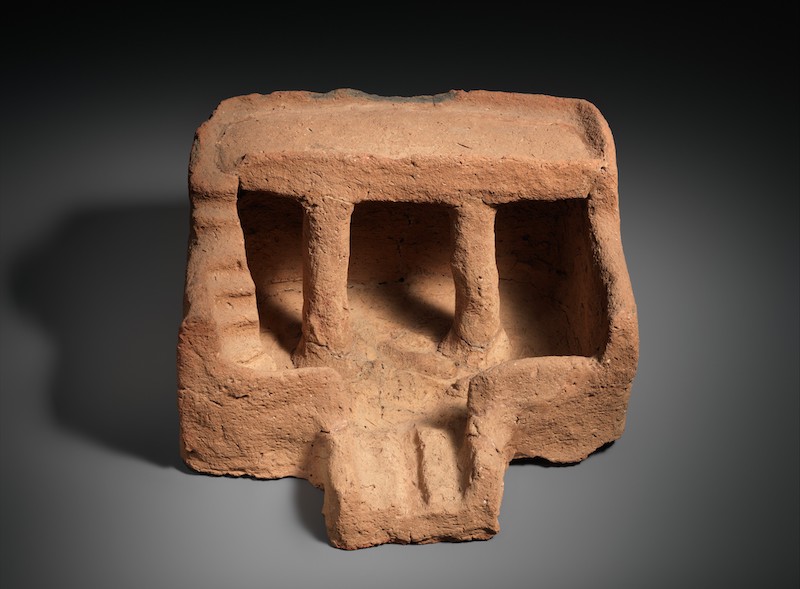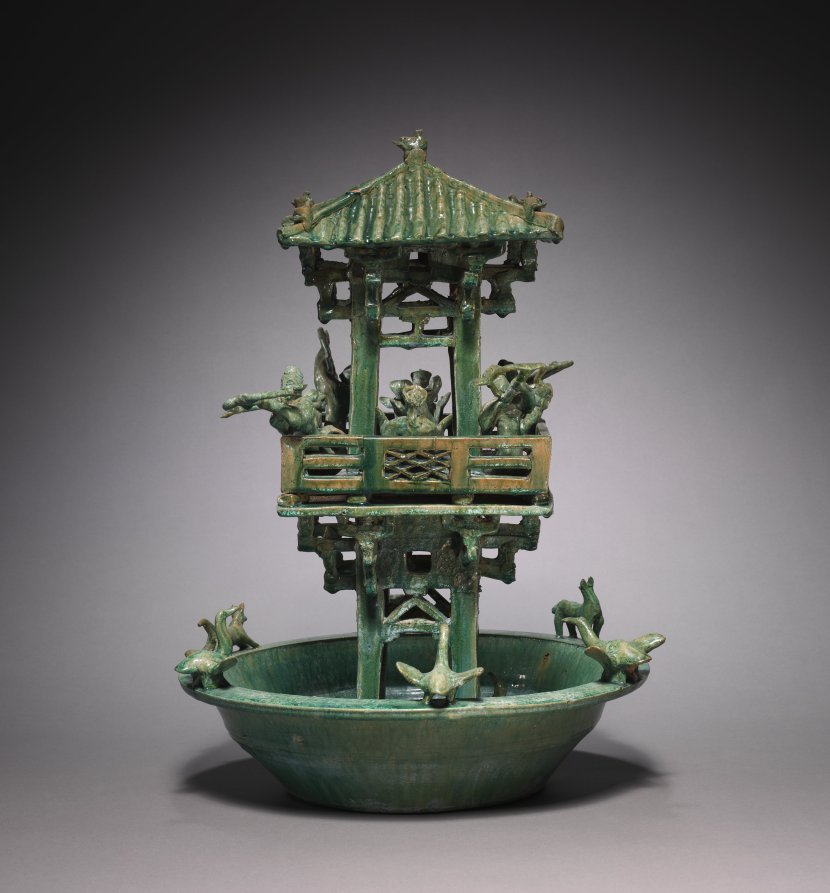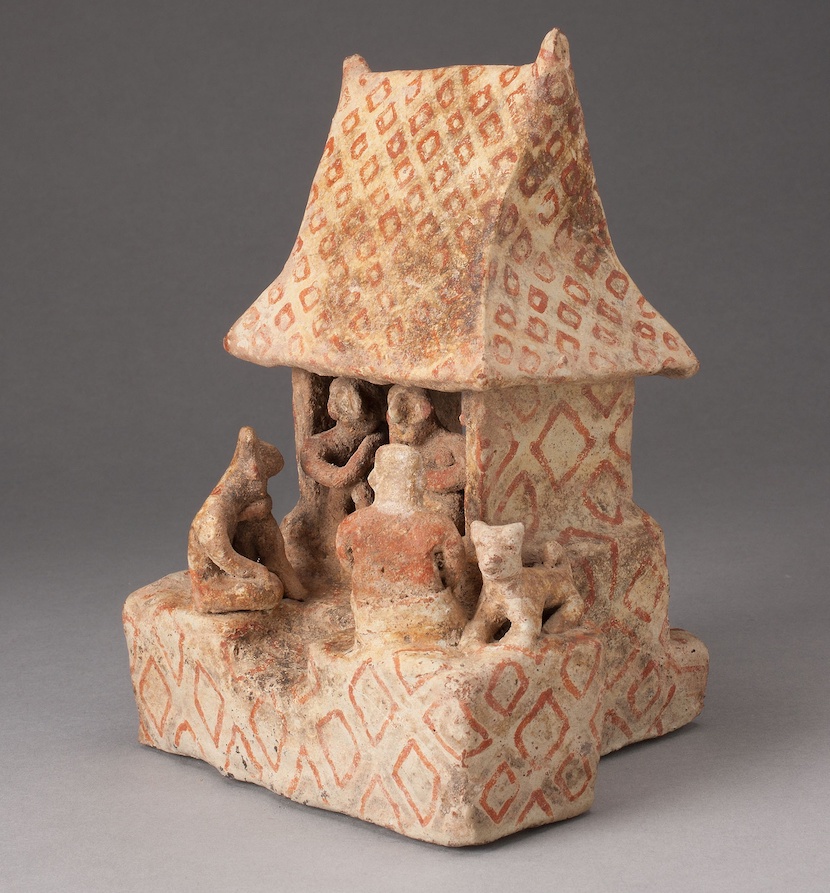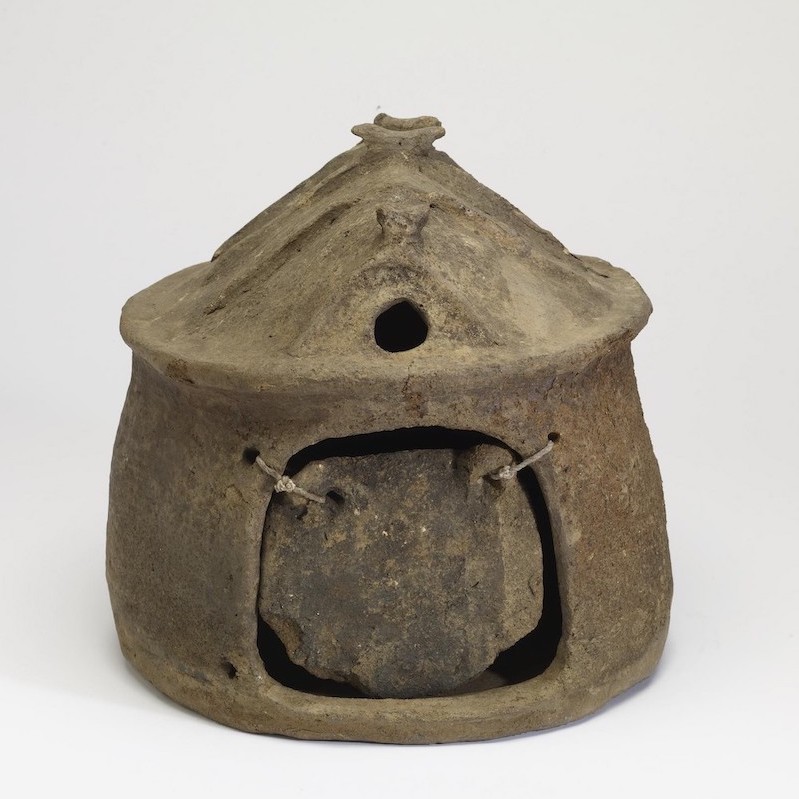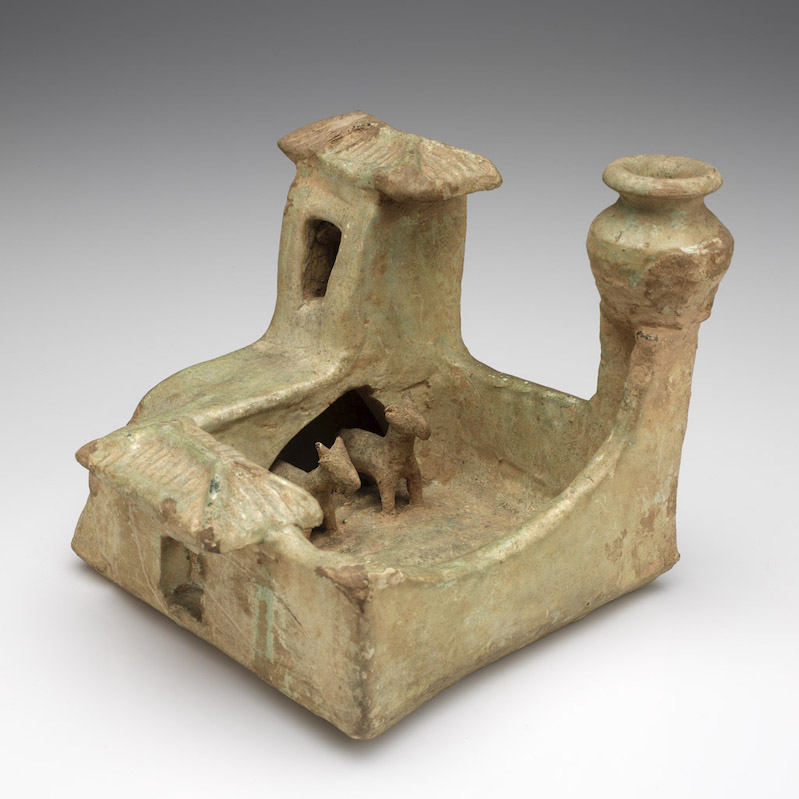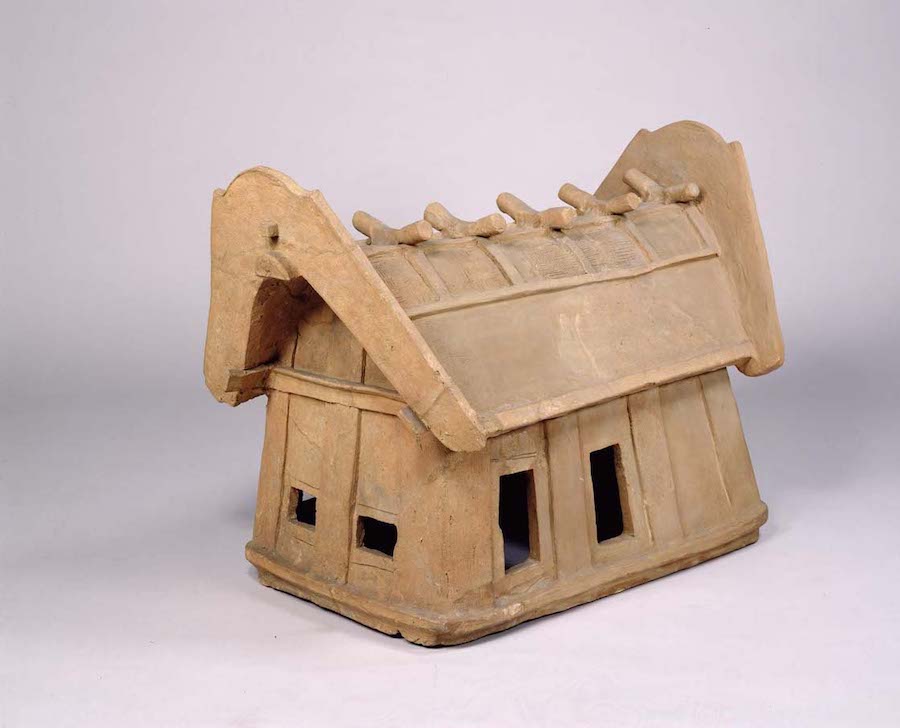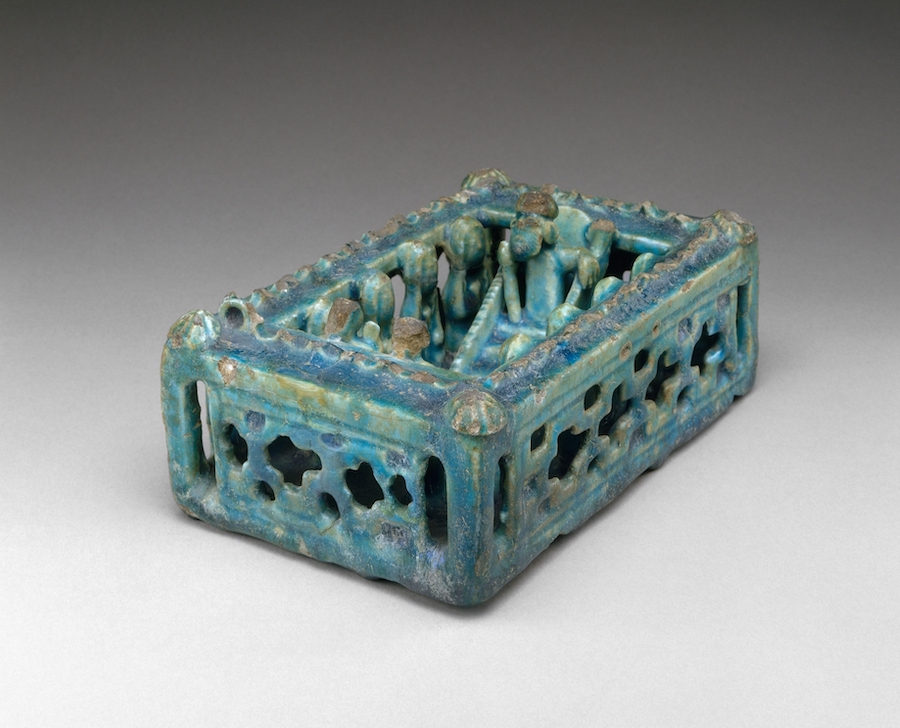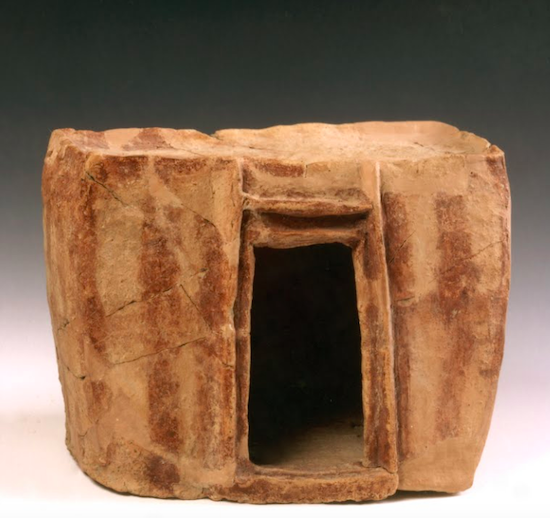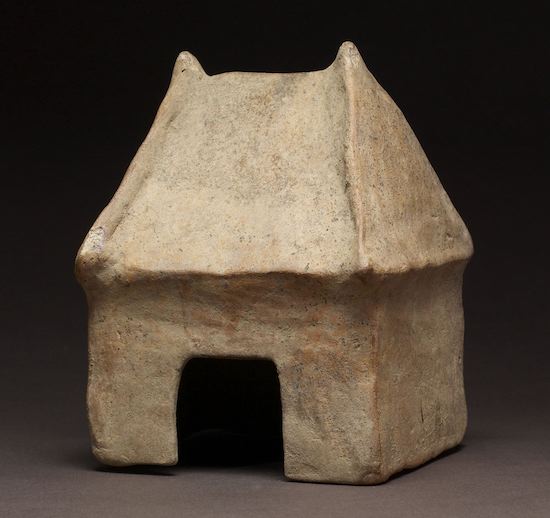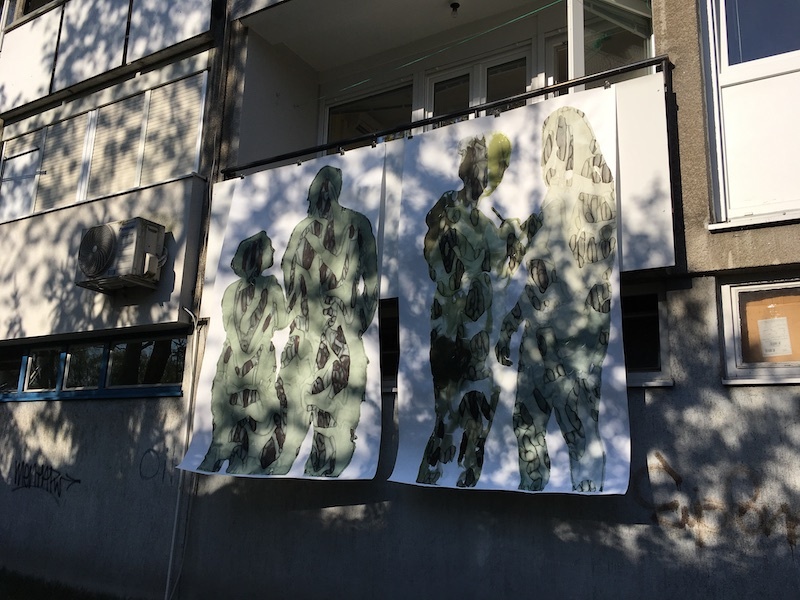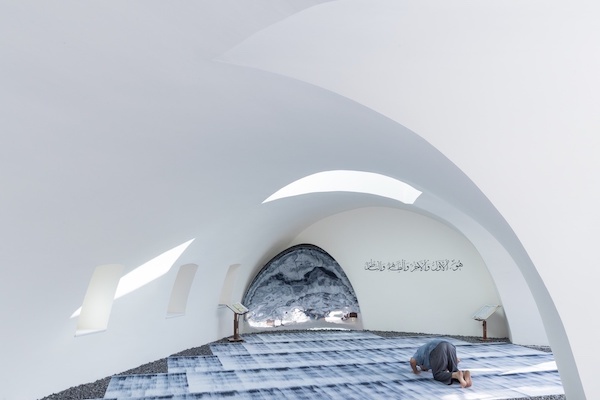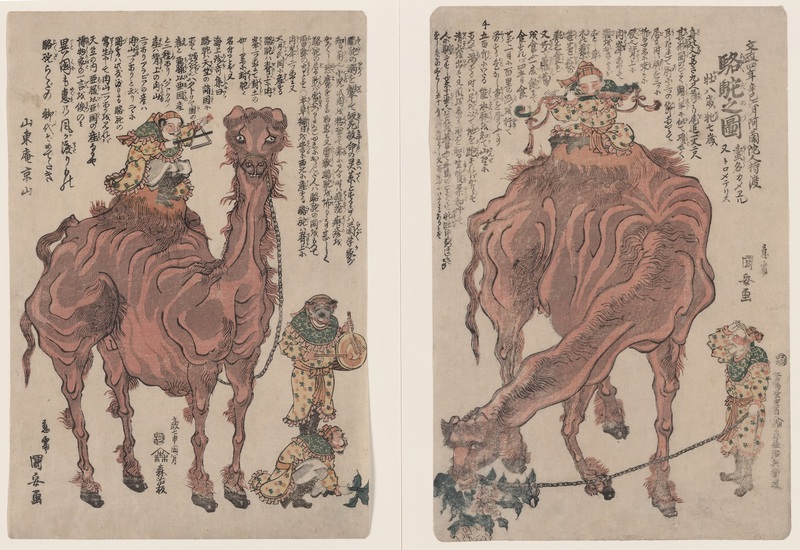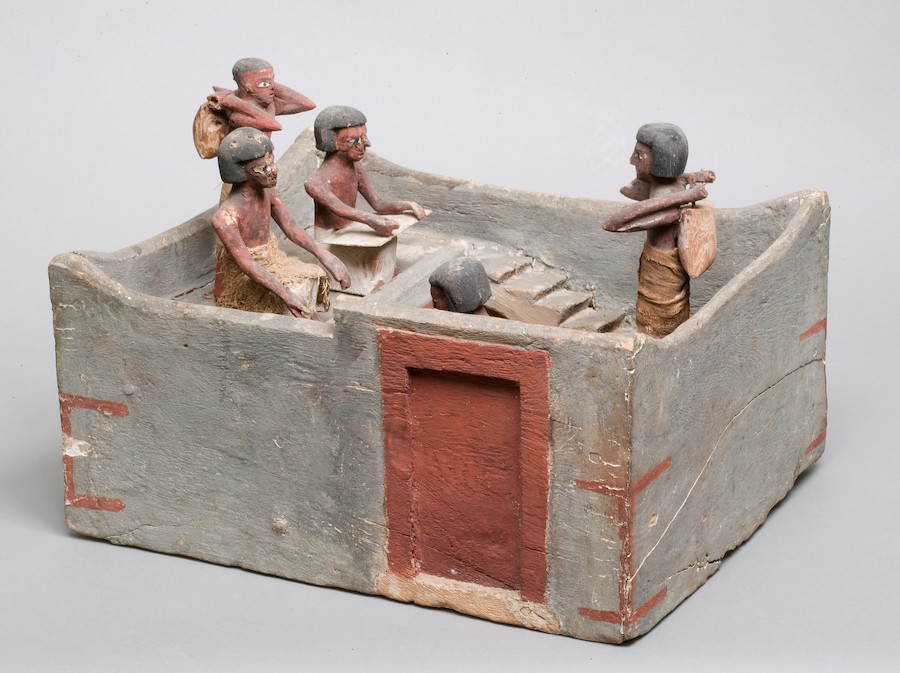
Model of a granary with a scribe and an overseer. The Middle Kingdom of Egypt, 2030–1850 BCE
11.150.3 / The Metropolitan Museum of ArtHome—a term banally conceived and poetically exalted, unites human realities and imaginations more than any other concept. I say concept, for it evokes a feeling of self-congratulatory belonging and self-sufficient ease—a state of being perpetually pursued and never fully realised. Throughout the history of humanity, “home” has journeyed from concrete happenings to abstract ideas. The exploration of humanity’s understanding of “home” is not only an archaeological search for our origins, but also a psychological probe into our mode of existence, and such an exploration is most fruitful through our languages, on which our perception of our identity and our surroundings has left indelible marks.
The hearth
It is hardly a generalisation to say that humanity’s first conceptualisation of home—a place for settlement—was associated with warmth, produced by the artificial means of a fire, which not only warmed the body but also filled the stomach with the delicacies it cooked. The hearth was for long the central point—or should I say, the focal (<Lat. focus “fire”) point of traditional human dwellings. Now that its significance has given way to central heating, the modern kitchen, and that little corner in many houses and flats called the fireplace, the hearth conjures up an image of cosy, rustic country living which, to the modern mind, belongs almost to simpler, innocent bygone eras. The importance of the hearth in the past made it synonymous with “home” and “family”, creating expressions such as “hearth and home” in the English language, and the family taxation called the “hearth tax” in many mediaeval societies.
The fire was so vital to early humans, and the hearth so central to a household, that they were deified and received devotional piety for human survival and prosperity. The monotheistic Zoroastrians considered the light and brightness of fire as an indication for the divine—an imagery inherited by the concept of divine light in Islam, particularly in Sufism. The deity अग्नि (Agni), the fire-god of the Vedic religion which shares the same origin as Zoroastrianism, is second in importance only to इन्द्र (Indra)—the equivalent of the Greek Ζεύς (Zeus). The Greek goddess Ἑστία (Hestia) is directly named after the hearth, possibly from the Indo-European root *h₂wes- “to dwell, to spend the night”, which points to the most primordial form of human existence.
On a lexical level, though, the hearth has not linked Eurasian societies with one another better than through the word ochaq, the Turkic word for it. Ocak in Turkish, ocaq in Azerbaijani, o‘choq in Uzbek, ئوچاق (ochaq) in Uyghur, ошақ (oshaq) in Kazakh, очок (ochoq) in Kyrgyz, учак (uchaq) in Tatar—all are descendants of the Old Turkic ochaq “fireplace”, related to the word ōt “fire”. This word has found its way into the languages which are not Turkic but have come into contact with Turkic speakers over the course of history. It has entered Persian, where اجاق (ojāq) now designates a stove that uses gas fire or coal, or simply the cooking hob. It has also entered Russian in the form of очаг (ochag), which is the traditional word for the fireplace or a stove that uses fire to cook food. It has given the Armenian օջախ (ojakh), which is used not only for “hearth”, but also metaphorically and emotively for “family and closed ones”, so often evoked in drinking toasts, whereas the native word for “family”, ընտանիք (ənt’anik), has more of a factual, physical meaning. Georgian, in its turn, has made the word the standard term for “family” —ოჯახი (ojakhi). If you have tasted the Georgian dish ოჯახური (ojakhuri), you will understand now why this heavy, hearty dish is fit to feed a family (ojakh “family” + -uri “-ish”). And speaking of food, I always find Turkish restaurants that call themselves ocakbaşı “fireside” endearing.
1996.116.16 / Brooklyn Museum Top right: Model of a house; functioned as an offering "table" on a grave. The Middle Kingdom of Egypt, 1750–1700 BCE
07.231.11 / The Metropolitan Museum of Art Bottom left: Funerary sculpture of a watchtower. Eastern Han dynasty of China, circa 25 BCE–220 CE
1989.71 / Cleveland Museum of Art Bottom right: House-shaped model depicting a ritual feast. Nayarit Culture, 100 ВСЕ–300 СЕ
1997.474 / The Art Institute of Chicago
In our modern times, the hearth has become synonymous with “association” in certain cultures through its broad semantic field. Ochaq’s concretisation into the form of a stove in Persian has not replaced the word for “hearth”, کانون (kānūn), which now most commonly designates a society or a club, conjuring up the image of like-minded people sitting around a bonfire discussing ideas that resonate in their hearts, hoping for new projects to be born – perhaps you and your companions count as a family and are at home with each other if your ambitions are one. The Turkish equivalent, ocak, also has the same meaning, and is used in the names of some organisations. کانون (kānūn) also exists in Arabic, and ultimately came from the Syriac kānōn “fireplace, hearth”, which also designates the time period on the Syriac Gregorian calendar corresponding to the December-January period, and which, of course, has given the Arabic كانون الأول (kānūn al-awwal, “first kānūn”) “December” and كانون الثاني (kānūn al-thānī, “second kānūn”) “January”. The modern Turkish name for January is no other than Ocak, translated from the Arabic کانون, which came from Syriac and by which the Turks also used to call their December and January.
The house
With the hearth fire comes the house—the physical manifestation of home, a shelter built around the hearth to make us humans feel safe. The most poetic—and I mean that literally—word for “house” among Eurasian civilisations is perhaps the word بيت (bayt) in Arabic, which means both a “house” and a “tent”, the latter evidently belonging to an earlier time when the Arabs, more precisely Bedouins, lived a nomadic lifestyle. Bayt comes from the triliteral root b-y-t, which gives the verb بات (bāt) that means “to spend the night somewhere”—reminiscent of the meaning of the Indo-European word *h₂wes-. The reason for which bayt is poetic, is that it not only designates a type of dwelling, but also a line of poetry. In Arabic poetic terminology, which has been adopted by all languages of the Islamic civilisation, a line of poetry is practically compared to a tent, because, according to the 10th-century linguist Abu Mansur al-Azhari from Herat (modern day Afghanistan), poetry is an ordered collection of words. Indeed, the Arabs also name the different constitutional parts of a poetic line after parts of the tent, and have created a sophisticated, veritable science of poetry through this technical metaphor of tent-making.
Yet, bayt meaning “house” has not ventured far beyond Arab culture. On the Eurasian continent, the two most shared words for “house” are the various modern derivatives of the Indo-European *dṓm and the Persian خانه (khāna).
The Indo-European word *dṓm “house” is what the English “domain”, “domestic”, “dominate”, and the name “Dominic” have in common. These English words all come from the Latin descendant of the Indo-European word, domus “house”, directly related to the Greek δόμος (dómos) “dwelling”, the Sanskrit दम (dama) “house”, the Russian дом (dom) “house”, the Armenian տուն (t’un) “house, home”, and the Albanian dhomë “chamber, room”. Less transparently, the English word dome also comes from this root, via the Latin domus. The association of the dome with “house” is hardly surprising, if we consider how the church is called the “House of God”, or in Latin, domus Dei, in Christianity, which is why, in fact, the Italian descendant of the Latin word domus, duomo, means “cathedral”, and so does Dom in German.
Even less obvious is the fact that the English word despot, from the Greek δεσπότης (despótēs), is also from the Indo-European *dṓm. It can be traced back to the Indo-European *dems potis “the one who owns the house” (*dems being a mutation of *dṓm), i.e. “the house master”, the paterfamilias, with the part *potis “master” related to the Albanian pata “to have”, the Sanskrit पति (pati) “husband”, and the Greek πόσις (pósis) “husband”. The Greek despótēs is the literal equivalent of the Sanskrit दम्पति (dampati), of which the feminine form, i.e. the female head of the family, is दम्पत्नि (dampatni). The Greek equivalent of the Sanskrit dampatni, δέσποινα (déspoina) “lady”, has come to be the title “miss” in Modern Greek.
The Persian خانه (khāna), ubiquitous in the Persianate Muslim world, came from the Indo-European root *h₂wes- “to dwell, to pass the night” mentioned earlier. Although less apparent now, the Indo-European root evolved into the Sanskrit वस (vas-), sister to the Avestan vaŋh-. The Old Persian āvahanam “village” contains the root (*h₂wes- > *vas- > *vah-) and is the direct ancestor of the Modern Persian خانه (khāna).
48.2312 / The Walters Art Museum Top right: Model of a walled farmyard. China, 1–200 CE
14.444 / RISD Museum Bottom left: Haniwa (a figure made for ritual use) from Chausuyama burial mound (Akabori, Gunma Prefecture). Japan, V century CE (Kofun period)
J-21140 / Tokyo National Museum Bottom right: Model of a house with a festive scene. Attributed to Iran, XII–XIII century
67.117 / The Metropolitan Museum of Art
While خانه (khāna) is used in Persian as an independent word meaning “house,” it is also used in compound nouns across Persianate languages denoting an enclosed space for an activity, and, as a result of the Persian language’s infinite possibility of generating compounds, we have an extraordinary amount of khānas across Eurasia, but my favourite — which I am sure is the favourite of many, too—is the چایخانه (chāykhāna), “tea-house”, an establishment, or let’s say a social system, that brings together people from all walks of life to discuss mundane or flamboyant ideas, all with the excuse of savouring the herbal drink that originated from China and spread all across the Silk Roads, accompanied, perhaps, by a bite into the succulent manti or samosa, or a taste of the chargrilled kabāb, whose aroma perpetually soaks the air, titillating one’s appetite for conviviality. It has been so central to Central Asian social life that the word has entered the Russian language as such, spelt as чайхана. In our contemporary world, although the traditional chāykhāna has now given way to fancy modern restaurants, cafés, and bars, which may or may not be willing to call themselves chāykhāna, its cultural legacy lives through its patrons who now continue to seek the same enjoyment in its offspring manifestations.
Khāna-compounds are usually quite transparent and say what they do on the tin. A less obvious example of khāna used in a compound, however, is the word دیوان (dīwān), whose two parts, dī and wān, are not actively used as independent words anymore. Originally, the dī came from the Old Persian dipi “writing, document”, which came from the Sumerian dub “clay tablet”, borrowed into Akkadian as ṭuppu, and gives Modern Persian the word دبیر (dabīr) “scribe, secretary” and the Armenian դպրոց (dp’rots) “school”; the wān is a phonetic corruption of the earlier form *vahanam, i.e. the modern khāna. Therefore, dīwān originally means a collection of writings, either in the form of a book or as an official establishment, i.e. the archive, and by extension, any official bureau or council. The imperial council of the Ottoman Empire was referred to as دیوان همایون Dīvān-i Humāyūn “The Auspicious Council”, and dīwān also refers to the audience hall at the Mughal imperial court. The contemporary western divan, meaning “couch” – not quite used in English but certainly common in French and Russian, certainly came from the metonymous usage of dīwān that came from the Europeans’ encounter with the bureaucratic cultures of the Islamic empires in the lands to their east. But this is a rather felicitous semantic change: what is a khānā (<*vahanam) without a comfortable divan (<*dipi-vahanam)?
1964-236 / The Israel Museum, Jerusalem Right: Architectural model depicting a typical West Mexican domicile or ceremonial building without its earthen platform. Colima culture, ca. 200-300 CE
2009.20.33 / The Walters Art Museum
Yet khāna is not the only word in Persian for “house”. There exists another word for “house”— کد (kad) or کده (kada), now seldom used as an independent word and has limited used in compounds, of which the most common example is the Persian word دانشکده (dānishkada) “college, institute”, which literally means “knowledge-house”. The word also features in the now obsolete terms کدبانو (kadbānū, lit. “house-lady”) and کدخدا (kadkhudā lit. “house-lord”), the former the semantic equivalent of the Greek déspoina and the Sanskrit dampatni and the latter of despotēs and dampati mentioned earlier. Whereas kadbānū remained the grande-dame of a household, the meaning of kadkhudā evolved into “village/town chief” during the Ilkhanid period, and then taken by the Seljuks and later the Ottomans as a title for a deputy official. The Talysh word kə and the Zoroastrian Dari word ked, both meaning “house”, are cognates with the Persian kad/kada and all can be traced back to a common Middle Iranian form katag.
The homeland
For many of us, home is a piece of land. Some call home the village, the town, and/or the country they were born in, whether they have lived their lives there or have spent most of their days away from them. Some, however, refuse the allotment of fate and prefer an unfamiliar land that delights their soul during their travels. Others lament the tempora and mores of their time and prefer indulging in a fantastical utopia of their minds’ fabrication to feel at home. To all, homeland is at once visceral and ideological — an extension of humanity’s innate desire to claim a space as their own, spatially and temporally, in order to dissipate the fear of alienation. The philosophical German word Heimat epitomises all the ineffable sentimentalities of “homeland”, sung and praised in endless volumes of eloquence by their poets and essayists.
This primitive desire is concretely reflected in the place name suffix -stan, ubiquitous on the Eurasian continent. The Persian suffix has its root in the Indo-European verb *steh2 “to stand, to place”, which has given ancient and modern Indo-European languages numerous words meaning “to be in an upright position”: the Latin stare, the English stand, the German stehen, the Russian стоять (stoyat’), etc., and also the permanence, or a desire for the permanence, of such a position: the English stay, the Russian ставать (stavat’) “to put” etc., and more importantly, the Latinate word existence and its verb to exist. To stand is to exist, and to exist is to live. The idea of “standing” is intricately linked to the idea of “stopping” and “halting”, as manifested by the Persian word ایستادن (īstādan) “to stand, to stop”, and “stopping” at the ideal position intimately carries a desire for continuity, thus “living”. Such is the tripartite semantics seen in Turkic languages, where the root tur- means “to stand”, “to stop”, as well as “to live”: many boys in Turkic-speaking countries are named Tursun “may he live” or Turdi “he has lived”, expressing the parents’ yearning for, as well as celebration of, life.
And life is exactly the idea hidden behind -stān. A stān is a place where whoever or whatever comes before it lives and exists. Originally a Persian term denoting a vague geographical area, either in the physical world or imagined, it became a vital linguistic tool for western colonialists who imposed borders and ethnic divisions in the “East”, namely in Central Asia, in their enterprise to name new national entities in the “native” way so as to create novel nationalisms that would fit their colonial goals. The Central Asian stans are familiar to all; less familiar, perhaps, are Հայաստան (Hayastan, “where the Hay, i.e. Armenians, live”), the native name for Armenia, Yunanistan (“where the Ionians live”), the Turkish name for Greece, Iryston (“where the Ir, i.e. Aryans live”), the native name for Ossetia, and Chinastan (“where the Chinese live”), the Armenian and the Sogdian name for China. The name राजस्थान (Rājasthān “Land of Kings”) also comes to mind, bearing the suffix -sthān, the same suffix in Sanskrit—Persian’s aunt.
In the Muslim world, the most common term for “homeland” is the Arabic word وطن (watan) in its many different ways of pronunciation, which oftentimes inspires pride, admiration, and nostalgia. These feelings are instilled in us by society in our most tender years, which also teaches us to see our homelands in parental terms, vividly represented, for example, in the various motherland statues across the former Soviet Union, as the homeland, indeed, is more often compared to the mother than the father across modern civilisations, betraying, perhaps, our innermost vulnerability that longs for caring protection and tender affection, embodied by our mothers. Our pride in our homeland’s might and desire for its perpetuity, on the other hand, probably lead us to compare it to our fathers, whose name and honour—so we hope—run in our veins and who defend our name and honour at any given time. Our complex, gendered relationship with our homelands is intrinsic to our languages, whether they have gendered nouns or not: English does not have noun genders, but the motherly figure of the homeland is apparent in the word motherland; the Turks do not have noun genders either, but this does not prevent them from gendering the word vatan - originally masculine in Arabic but genderless as a loanword in Turkish - as ana vatan “mother homeland”. Romance languages blend mother and father together in their various forms of the Latin patria, which comes from the word pater “father” whilst being a feminine noun, and so does Greek with the word πατρίδα (patrída), a feminine noun that comes from πατήρ (patēr) “father”. Germanic languages, except English, seem overwhelmingly to prefer the designation “fatherland”, with the German Vaterland, the Dutch vaderland, the Danish fædreland, the Norwegian fedreland, the Swedish fädernesland, the Icelandic föðurland, etc, and so do Russians, who, although referring to Russia with the endearing term Россия-матушка (Rossiya-matushka) “Mother Russia”, have the word отечество (otechestvo) for “homeland” — a neuter word that comes from отец (otets) “father”. The Chinese, so deeply reverent towards their ancestors, however, use the word 祖国 (zǔguó) “ancestral land”.
For many born in the diaspora or living in exile, who shun the grandiloquence of “motherland”, “fatherland”, and “ancestral land”, too politicised not to invite scrutiny, the homeland is simply their mother tongue: as the physical representation of “homeland” becomes too elusive to grasp, language becomes the only reassuring constant. The Portuguese poet Fernando Pessoa, who spent his formative years in South Africa, away from his birthplace Lisbon, famously claims, “A minha pátria é a língua portuguesa” (“My homeland is the Portuguese language”), soulfully describing the comfort of being moulded by and moulding one’s mother tongue—a sentiment heartily shared by the Alexandrian Greek poet Constantine Cavafy, and echoed in the works of the exiled Iranian poet Esmail Khoi.
Perhaps there need not be so much philosophising about “home”, because, after all, as the clichéd English saying goes, “home is where the heart is”. The heart is our sense of selfhood, and it can be anchored in one thing, or it can be a composite of many factors. The globalised modern world is a perplexing one, but as long as your self is firm and strong, you have a home wherever life’s happenstance takes you.

